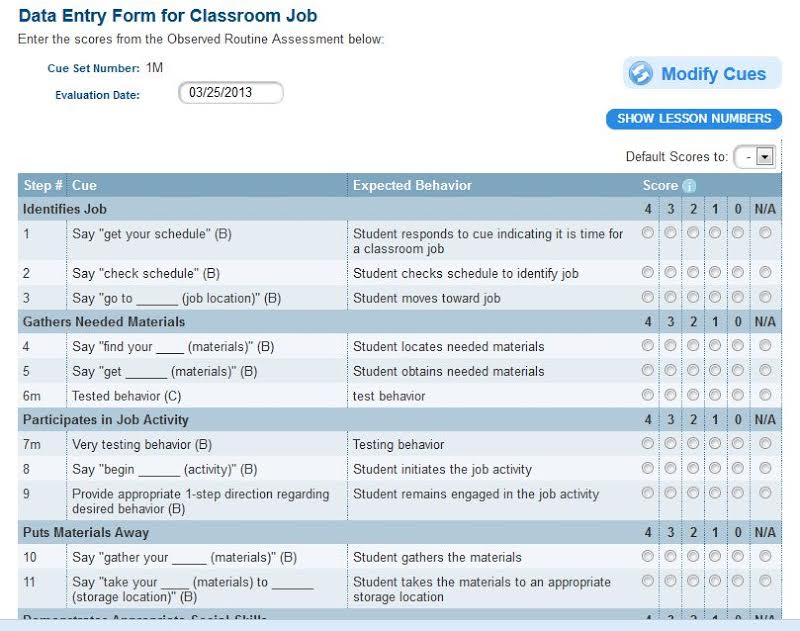By: Joel Arick, Ph.D.
The Autism Society of America reports in a recent newsletter an alarming statistic, only 21% of Americans living with a disability are employed or seeking employment. How can schools and Autism Specialists make an impact to change these statistics?
When working with students and young adults with autism a significant challenge exists in choosing methods and curricula that will make a positive impact on the individual and their family after they have left school. Teaching functional skills needed to be active, engaged members of the community is an important first step in improving employment rates for the many adults living with a disability.
When researching strategies and curricula for working with secondary and post-secondary students it is imperative that staff utilize age appropriate programming. A number of appropriate themes, content and instructional methods have been identified as appropriate for secondary and post-secondary students.
One of the most effective strategies for improved outcomes for students with ASD is utilizing Task Analysis to teach students school, community and vocational routines. Task analysis involves breaking down a skill or routine into its foundational steps. Routines refer to activities that have a predictable sequence of steps, take place at a specific time of day, and have consistent expectations for participation and independent performance. Examples of routines include Going to School, Eating Lunch and Socializing with Friends. In behavioral terms, a routine is a chain of behaviors (Alberto & Troutman, 2009; Cooper, Heron, & Heward, 2007).
Teaching students the skills to complete each step of a routine results in a functional outcome, such as completing a work task or purchasing an item. When learning the steps of a new routine, students often require instruction in the foundational skills necessary to perform the steps of the routine. Utilizing effective instructional strategies, such as discrete trial training, will teach important foundational skills resulting in increased independence and success during routines.
The International Board of Credentialing and Continuing Education Standards (IBCCES) has discovered a program that specifically addresses the challenge of educating secondary students with ASD. The Links® Curriculum is a functional curriculum that links newly acquired academic, language and social skills to the routines students participate in throughout the day. The Links program provides 47 pre-written, task analyzed routines, as well as the ability to customize your own routines. These routines reflect the daily activities students engage in across school and community settings. Assessment of individual routines determine the level of support students need to complete the routine, then individual lesson plans (e.g., making requests, using a daily schedule, identifying people) are provided that teach the new skills necessary to perform individual steps of the routine more independently. Linking newly acquired language and academic skills to everyday routines helps develop important life skills, leading to increased independence.
The Links® Curriculum is presented by STAR® Autism Support, the founders of award winning curricula for all ages. To learn more about Links® and STAR®, click on the links below.
Joel Arick, Ph.D. is Professor Emeritus at Portland State University. Dr. Arick is the lead author of the STAR Program (Arick, Loos, Falco & Krug, 2004) and Links Curriculum. Dr. Arick has 30 years of experience working in the field of autism. He is also a co-author of several other published programs in the area of autism. These programs include the ASIEP-3 (Autism Screening Instrument for EducationalPlanning-3, 2004), the KADI (Krug Asperger Disorder Index,2003), and the FACTER Program (Functional Assessment and Curriculum for Teaching Everyday Routines, 2004). Dr. Arick, with colleagues, has been measuring the progress of children educated using the STAR Autism Program, over the past ten years. He is also an author of a chapter entitled “School-based Programs for Children with Autism” in the Handbook on Autism (2005). Dr Arick is Professor Emeritus at Portland State University. References: Alberto, P., & Troutman, A. (2009). Applied behavior analysis for teachers. Upper Saddle River, NJ: Merrill/Pearson. Autism Society of America. (2013, March). Newsletter Cooper, J.O., Heron, T.E., & Heward, W.L. (2007). Applied behavior analysis (2nd ed.). Upper Saddle River, NJ: Pearson/Merrill-Prentice Hall. Kavale, K.A., & S. R. Forness (1999). Efficacy of special education and related services. Washington DC: American Association on Mental Retardation. Lovaas, O.I. (1987). Behavioral treatment and normal educational and intellectual functioning in young autistic children. Journal of Consulting and Clinical Psychology, 55, 3-9. National Autism Center (2009). National Standards Project findings and conclusions: Addressing the need for evidence-based practice guidelines for Autism Spectrum Disorders. Randolph, MA: National Autism Center. National Professional Development Center (2010). Comparison with National Standards Project. Retrieved from http://autismpdc.fpg.unc.edu/content/national-standards-project. National Research Council (2001). Educating children with autism. Committee on Educational Interventions for Children With Autism, Division of Behavioral and Social Sciences and Education. Washington, DC: National Academy Press. Snell, M.E., & Brown, F. (2006). Instruction of Students with Severe Disabilities (6th ed.). Columbus, OH: Pearson Prentice Hall. Wehmeyer, M.L., & Schwartz, M. (1998). The relationship between self-determination, quality of life, and life satisfaction for adults with mental retardation. Education and Training in Mental Retardation and Developmental Disabilities, 33, 2-12.FEB


